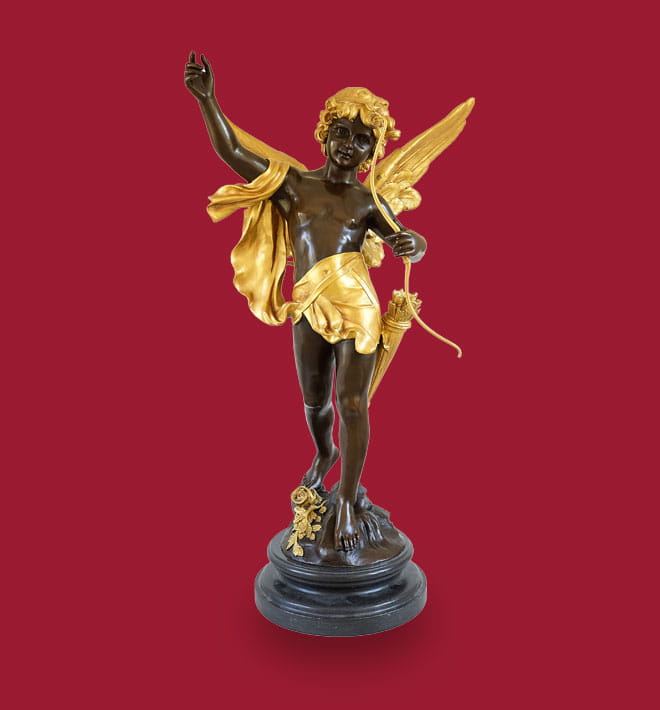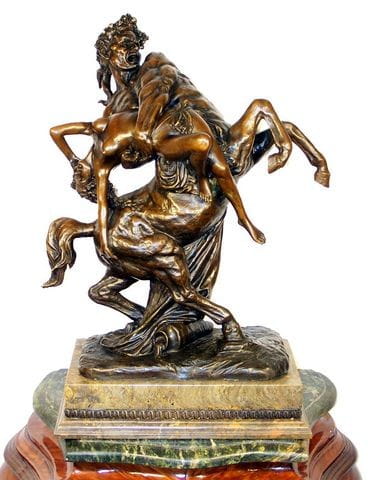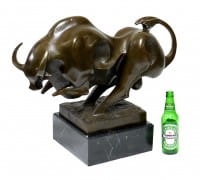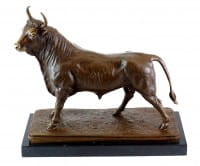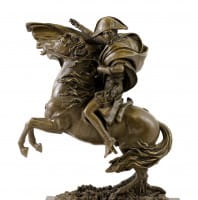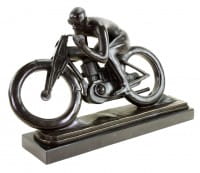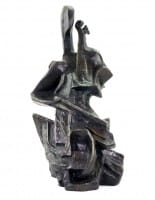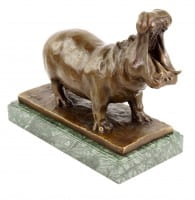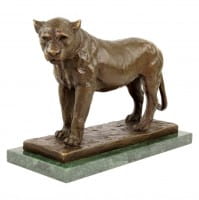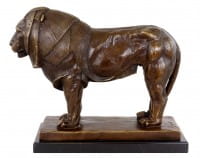€2,499.00 *
Prices incl. VAT, free shipping worldwide
Ready to ship today,
Delivery time appr. 3-6 workdays










Big Centaur – A Mythological Bronze Masterpiece - Signed C. B. Aibert This extraordinary... more
Product description
"Centaur Statue - Greek Sculpture - C.B. Aibert signed"
| Weight | 26,6 kg |
Big Centaur – A Mythological Bronze Masterpiece - Signed C. B. Aibert
This extraordinary Centaur Statue by the elusive sculptor C. B. Aibert captures the wild and tragic spirit of Greek mythology in breathtaking detail. The powerful creature, half man and half horse, is shown in mid-motion, carrying a struggling female figure in his muscular arms. The contrast between his raw physical strength and the delicate vulnerability of the woman creates a scene charged with tension and emotion. Every vein, muscle, and curve is modeled with exceptional realism, giving the bronze surface a sense of movement that feels almost alive. The sculpture evokes both awe and contemplation — a timeless reflection of man’s struggle between instinct and reason, so central to the myth of the Centaur Figure.
A Vision Rooted in Ancient Greece
The theme of the centaur has been celebrated for centuries, from the marble friezes of the Parthenon to the bronzes of the Renaissance. In this work, C. B. Aibert pays homage to that ancient legacy while infusing it with emotional drama and technical mastery. The figure of the centaur, drawn from the myths of Thessaly, represents the untamed forces of nature and desire, often clashing with human ideals of order and morality. By depicting the centaur with such intense vitality, Aibert transforms myth into a living presence. The polished bronze amplifies the narrative tension — the gleam of the metal heightening both the violence and beauty inherent in this Greek Statue.
The Enigmatic Sculptor C. B. Aibert
Although little biographical information survives about C. B. Aibert, records suggest that he was active in France during the late nineteenth and early twentieth centuries, working primarily in bronze. Trained in the classical academic tradition, Aibert was part of a generation of sculptors who revived ancient themes with renewed vigor and sensuality. His fascination with mythological subjects reveals a deep understanding of Greek literature and the human condition. Aibert’s workshop is believed to have collaborated with skilled foundries in Paris, where his most ambitious bronzes were produced. Through works like this Centaur Statue, he left behind an artistic legacy defined by anatomical precision, dramatic storytelling, and reverence for antiquity.
Mythical Symbolism and Emotional Depth
The Centaur Figure has always stood as a symbol of duality — half beast, half man — representing the eternal conflict between animal instinct and rational thought. In Aibert’s interpretation, this duality becomes physical and emotional. The centaur’s body twists in a spiral of tension, his human torso straining upward while his equine legs anchor him to the earth. The woman’s form drapes across his arms like a counterweight to his power, her limp body contrasting with his fierce determination. The sculptor captures a moment of transformation, where brutality meets tragedy, and myth becomes human. This depth of feeling elevates the work far beyond decorative purpose, making it one of the most compelling Greek Statue interpretations of its kind.
Technical Mastery and Timeless Craft
The technical execution of this Centaur Statue demonstrates an extraordinary understanding of the lost-wax casting method. The surface reveals subtle variations in patina — warm bronze tones shifting between golden highlights and deep shadows — creating a dynamic visual rhythm. The detailing in the centaur’s mane, the woman’s flowing form, and the textured base reveal countless hours of meticulous craftsmanship. Mounted on a finely polished marble plinth, the composition achieves perfect balance, both physically and aesthetically. The sculptor’s ability to convey strength, emotion, and motion in a single piece underscores his profound mastery of the medium. This is not merely a representation of myth but a testament to human creativity itself.
Legacy and Modern Appreciation
Today, bronzes by C. B. Aibert, including this monumental Centaur Figure, can be found in select private collections and European galleries dedicated to classical revival sculpture. Collectors and scholars alike admire his ability to merge ancient narrative with expressive realism, bridging the gap between mythology and emotion. His Greek Statue compositions are prized for their dramatic intensity and technical refinement, standing among the finest mythological bronzes of their time. They continue to inspire modern admirers who appreciate their sculptural beauty and timeless storytelling. In interior design, such a work serves as a centerpiece for those seeking refined Greek Decoration Ideas, combining history, mythology, and craftsmanship in one enduring form.
Eternal Motion in Bronze
This Centaur Statue by C. B. Aibert remains a profound embodiment of mythic power, human vulnerability, and artistic genius. It captures the eternal rhythm of struggle and beauty that defines the legacy of classical sculpture. The viewer feels drawn into its movement, caught between the force of the centaur’s stride and the pathos of his burden. More than a work of myth, it is a meditation on the passions that drive humanity — rendered in bronze that will endure as long as the stories of Greece themselves.
This extraordinary Centaur Statue by the elusive sculptor C. B. Aibert captures the wild and tragic spirit of Greek mythology in breathtaking detail. The powerful creature, half man and half horse, is shown in mid-motion, carrying a struggling female figure in his muscular arms. The contrast between his raw physical strength and the delicate vulnerability of the woman creates a scene charged with tension and emotion. Every vein, muscle, and curve is modeled with exceptional realism, giving the bronze surface a sense of movement that feels almost alive. The sculpture evokes both awe and contemplation — a timeless reflection of man’s struggle between instinct and reason, so central to the myth of the Centaur Figure.
A Vision Rooted in Ancient Greece
The theme of the centaur has been celebrated for centuries, from the marble friezes of the Parthenon to the bronzes of the Renaissance. In this work, C. B. Aibert pays homage to that ancient legacy while infusing it with emotional drama and technical mastery. The figure of the centaur, drawn from the myths of Thessaly, represents the untamed forces of nature and desire, often clashing with human ideals of order and morality. By depicting the centaur with such intense vitality, Aibert transforms myth into a living presence. The polished bronze amplifies the narrative tension — the gleam of the metal heightening both the violence and beauty inherent in this Greek Statue.
The Enigmatic Sculptor C. B. Aibert
Although little biographical information survives about C. B. Aibert, records suggest that he was active in France during the late nineteenth and early twentieth centuries, working primarily in bronze. Trained in the classical academic tradition, Aibert was part of a generation of sculptors who revived ancient themes with renewed vigor and sensuality. His fascination with mythological subjects reveals a deep understanding of Greek literature and the human condition. Aibert’s workshop is believed to have collaborated with skilled foundries in Paris, where his most ambitious bronzes were produced. Through works like this Centaur Statue, he left behind an artistic legacy defined by anatomical precision, dramatic storytelling, and reverence for antiquity.
Mythical Symbolism and Emotional Depth
The Centaur Figure has always stood as a symbol of duality — half beast, half man — representing the eternal conflict between animal instinct and rational thought. In Aibert’s interpretation, this duality becomes physical and emotional. The centaur’s body twists in a spiral of tension, his human torso straining upward while his equine legs anchor him to the earth. The woman’s form drapes across his arms like a counterweight to his power, her limp body contrasting with his fierce determination. The sculptor captures a moment of transformation, where brutality meets tragedy, and myth becomes human. This depth of feeling elevates the work far beyond decorative purpose, making it one of the most compelling Greek Statue interpretations of its kind.
Technical Mastery and Timeless Craft
The technical execution of this Centaur Statue demonstrates an extraordinary understanding of the lost-wax casting method. The surface reveals subtle variations in patina — warm bronze tones shifting between golden highlights and deep shadows — creating a dynamic visual rhythm. The detailing in the centaur’s mane, the woman’s flowing form, and the textured base reveal countless hours of meticulous craftsmanship. Mounted on a finely polished marble plinth, the composition achieves perfect balance, both physically and aesthetically. The sculptor’s ability to convey strength, emotion, and motion in a single piece underscores his profound mastery of the medium. This is not merely a representation of myth but a testament to human creativity itself.
Legacy and Modern Appreciation
Today, bronzes by C. B. Aibert, including this monumental Centaur Figure, can be found in select private collections and European galleries dedicated to classical revival sculpture. Collectors and scholars alike admire his ability to merge ancient narrative with expressive realism, bridging the gap between mythology and emotion. His Greek Statue compositions are prized for their dramatic intensity and technical refinement, standing among the finest mythological bronzes of their time. They continue to inspire modern admirers who appreciate their sculptural beauty and timeless storytelling. In interior design, such a work serves as a centerpiece for those seeking refined Greek Decoration Ideas, combining history, mythology, and craftsmanship in one enduring form.
Eternal Motion in Bronze
This Centaur Statue by C. B. Aibert remains a profound embodiment of mythic power, human vulnerability, and artistic genius. It captures the eternal rhythm of struggle and beauty that defines the legacy of classical sculpture. The viewer feels drawn into its movement, caught between the force of the centaur’s stride and the pathos of his burden. More than a work of myth, it is a meditation on the passions that drive humanity — rendered in bronze that will endure as long as the stories of Greece themselves.
Width: 40 cm
Height: 55 cm
Depth: 26 cm
Weight: 26,6 kg
100% Bronze
Related links to "Centaur Statue - Greek Sculpture - C.B. Aibert signed"
Read, write and discuss reviews... more
Customer evaluation for "Centaur Statue - Greek Sculpture - C.B. Aibert signed"
Write an evaluation
Evaluations will be activated after verification.
Our advantages
free shipping
Worldwide free shipping
14 days money back
You can cancel your order
within 14 days
secure payment services
Paypal, Master Card, Visa, American Express and more
NEW
NEW
NEW
NEW

